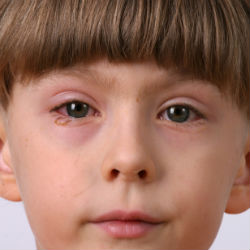Pink Eye (Conjunctivitis) explained

What’s red, swollen and itchy, and can cause a child’s eyes to be pink or red and the eyelids to be glued together upon awakening? You guessed it: pink eye, or conjunctivitis to use medical jargon. It is one of the most common non-traumatic eye complaints seen in emergency rooms.
Specifically, pink eye is an inflammation of the transparent membrane that lines the eyelid and part of the eyeball. This inflammation causes small blood vessels in the membrane to become more prominent, which is what causes the pink or red cast to the whites of the eyes. If the cause is bacterial, there will be a green or yellow discharge from the eyes.
While the condition may seem alarming because it may make your child’s eyes extremely itchy and the infection is very contagious, it causes no long-term eye damage. However, if your child shows symptoms of pink eye, it's important to see a doctor to receive the right treatment.
Causes and symptoms
Causes and symptoms
The cause of pink eye is commonly a viral or bacterial infection, or an allergic reaction. Viral conjunctivitis is the most common cause of pink eye.
In babies, a condition may develop in which the tear ducts (unilaterally or bilaterally) are blocked. These babies will have watery eyes and occasionally the duct may become infected. This will case the watery discharge to change to a yellow or green discharge. The condition is generally treated with massage of the tear duct, and antibiotic ointments or drops are only used if an infection develops.
The most common pink eye symptoms include:
- Redness in one or both eyes
- Itchiness in one or both eyes
- An increased production of tears
- Sensitivity to light
- A discharge in one or both eyes that forms a crust during the night and ‘glues’ the eyelids shut
Contagiousness
Contagiousness
Pink eye can be highly contagious for as long as two weeks after signs and symptoms appear. It is best to see a doctor if you notice any signs or symptoms of pink eye in children to get treatment and avoid infecting others.
For kids diagnosed with contagious conjunctivitis, doctors usually recommend keeping them out of school, day care, or summer camp for a short time until the eye has been treated and discharge is no longer present.
Someone who has pink eye in one eye can also inadvertently spread it to the other eye by touching the infected eye, and then touching the uninfected eye.
Preventing Pink Eye
To prevent the itching, scratching and swelling that comes with conjunctivitis, there are a number of things you can do. Consider the following tips:
- Teach kids to wash their hands often with soap and warm water to avoid the spread of bacteria
- Make sure your children know that they shouldn’t share personal hygiene products with others (this includes tissues, eye makeup, washcloths, towels, and extends to pillowcases and eye drops as well)
- Be sure to wash your own hands thoroughly after touching an infected child's eyes, and throw away items like gauze, Kleenex or cotton balls after use
- Wash towels and other linens that your child has used in hot water separately from the rest of the family's laundry to avoid contamination
If you know your child is prone to allergic conjunctivitis:
- Keep windows and doors closed on days when the pollen is heavy
- Dust and vacuum frequently to limit allergy triggers in the home
Treatment
Treatment
While some cases of conjunctivitis (viral) can go away on their own, it is always best to see a doctor, who can then determine if the infection is caused by bacteria, a virus or an allergic reaction. A doctor will then prescribe the correct treatment, which can include antibiotic eye drops or ointment and possibly warm compresses.
Teens who wear contact lenses will be advised to stop wearing them until the pink eye has resolved. Similarly, eye makeup and cosmetic creams should not be used in the eye area until symptoms of pink eye have disappeared and/or antibiotic eye drops are no longer needed. Online sources:


